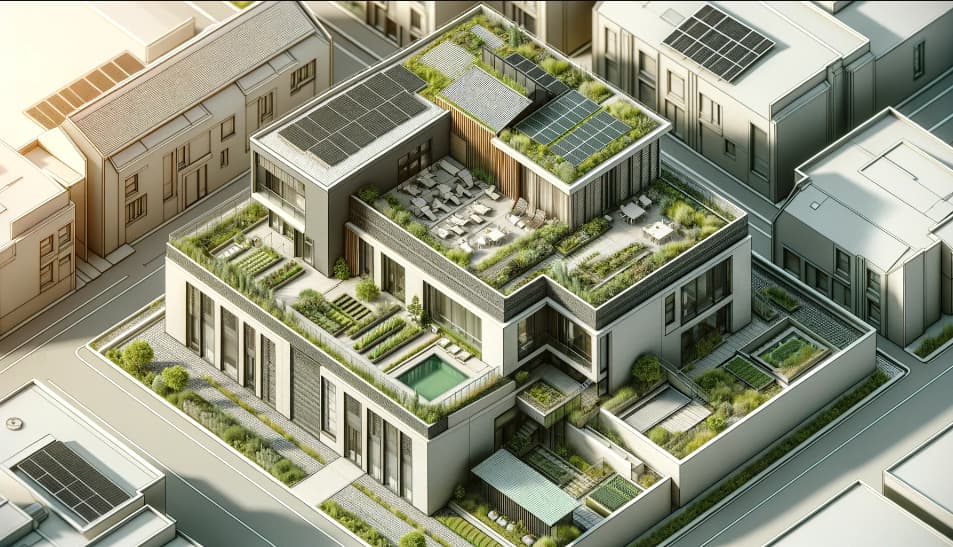Roofing
Flat Roof – Decoding: Installation, Maintenance, and Materials
Flat Roof? When the word “roof” comes to mind, many envision the traditional pitched and sloped structures that adorn the tops of most homes.
However, the world of roofing is far more varied and includes options that might not immediately spring to mind, such as the flat roof.
Not only is this style gaining traction for its modern aesthetic and practical benefits, but it also offers a plethora of types to choose from, each with its unique advantages.
2. Understanding Flat Roofs
Flat roofs, contrary to their name, aren’t entirely flat but rather have a slight slope, typically less than 10 degrees.
This subtle incline is crucial for drainage, ensuring that rainwater and debris flow off the roof efficiently. Without proper drainage, stagnant water can accumulate, leading to structural issues and leaks.
Types of Flat Roofs:
2.1. Built-Up Roofing (BUR):
- Overview: BUR roofs, also known as tar and gravel roofs, have been a staple in the roofing industry for over a century. They consist of multiple layers of bitumen and reinforcing fabrics topped with gravel or mineral granules.
- Pros: Known for their durability and fire resistance, BUR roofs offer excellent protection against UV rays and harsh weather conditions.
- Cons: Despite their longevity, BUR roofs can be heavy and prone to leaks if not properly installed or maintained.
2.2. Single-Ply Membrane Roofs:
- Overview: Single-ply membrane roofs, such as EPDM, TPO, and PVC, are made of flexible sheets of synthetic materials that are mechanically fastened, adhered, or ballasted to the roof substrate.
- Pros: These roofs are lightweight, easy to install, and offer good resistance to UV radiation and chemicals.
- Cons: While single-ply membranes are durable, they can be susceptible to punctures and require regular inspections and maintenance.
2.3. Modified Bitumen Roofing:
- Overview: Modified bitumen roofs are made from asphalt-based materials modified with polymers to enhance flexibility, durability, and UV resistance.
- Pros: These roofs offer excellent tensile strength and flexibility, making them suitable for buildings with movement or settling.
- Cons: Installation can be complex, and improper application may lead to premature failure or leaks.
2.4. Green Roofs:
- Overview: Green roofs, also known as living roofs, feature a layer of vegetation planted over a waterproof membrane. They provide numerous environmental benefits, including improved air quality, reduced urban heat island effect, and stormwater management.
- Pros: Green roofs offer natural insulation, extend roof lifespan, and create aesthetically pleasing outdoor spaces.
- Cons: They require specialized design and maintenance, including irrigation and plant care, and may add significant weight to the structure.
3. The Advantages of Choosing a Flat Roof
Flat roofs offer a range of benefits that make them a popular choice for both residential and commercial buildings. Here’s a closer look at why opting for a flat roof might be advantageous:
3.1. Versatility in Design:
When considering a flat roof, you have the flexibility to design your space according to your specific needs and preferences.
Whether you envision a rooftop garden, outdoor entertainment area, or solar panel installation, flat roofs provide a versatile platform to bring your ideas to life.
Explore various design possibilities with a qualified architect or designer to maximize the potential of your flat roof space.
3.2. Cost-Effectiveness:
Flat roofs are often more cost-effective to install compared to pitched roofs, thanks to their simpler design and construction requirements.
Additionally, maintenance and repair costs for flat roofs tend to be lower, contributing to long-term savings for property owners.
Consider the potential cost savings of a flat roof when planning your roofing project and explore financing options available through reputable roofing contractors or financial institutions.
3.3. Energy Efficiency:
Flat roofs can be designed with energy-efficient features to help reduce heating and cooling costs.
Options such as reflective roof coatings, insulation upgrades, and green roof installations can enhance the energy performance of your building, leading to lower utility bills and reduced environmental impact.
Partner with a certified energy consultant or roofing contractor to assess your energy needs and identify cost-effective solutions for optimizing your flat roof’s efficiency.
3.4. Accessibility and Maintenance:
Unlike pitched roofs, which can be challenging to access and maintain, flat roofs offer easier accessibility for routine inspections, repairs, and equipment installations.
This accessibility translates to lower maintenance costs and faster turnaround times for maintenance tasks, ensuring that your roof remains in top condition year-round.
Explore preventive maintenance plans offered by reputable roofing companies to safeguard your investment and prolong the lifespan of your flat roof.
3.5. Space Utilization:
Flat roofs provide valuable additional space that can be utilized for various purposes, including outdoor living areas, rooftop gardens, and recreational spaces.
By maximizing the use of your flat roof, you can enhance the functionality and enjoyment of your property while adding aesthetic appeal and resale value.
Consider incorporating innovative design elements and amenities into your flat roof space to create a unique and inviting environment for residents, employees, or guests.
4. 10 Types of Flat Roof Materials
4.1. Built-Up Roofing (BUR)
The classic “tar and gravel” roof, BUR, is both economical and durable, making it a popular choice for those seeking a balance between cost and longevity.
For DIY enthusiasts or those considering professional installation, this roofing kit might be the perfect start.
4.2. Concrete Roofs
Concrete’s strength and durability extend to roofing, where it offers unmatched longevity and resistance to the elements.
To ensure your concrete roof remains waterproof and durable, this concrete sealant is a must-have.
4.3. EPDM Roofing
EPDM stands out for its affordability and durability, particularly in cooler climates. For repairs or installations, having an EPDM kit on hand can save time and money.
4.4. Glass Reinforced Polyester (GRP)
GRP’s durability and weather resistance make it a great choice, though it’s best to limit foot traffic. For minor repairs or installations, this GRP repair kit can be incredibly handy.
4.5. Green Roofs
For the eco-conscious homeowner, green roofs not only offer a return to nature but also significant environmental benefits. Starting a green roof can be daunting, but this starter kit can help you begin.
4.6. Metal Roofs
Metal roofs provide a blend of recyclability, durability, and customizability, with a range of materials to choose from. To keep your metal roof in top condition, consider this maintenance product.
4.7. Modified Bitumen Systems (MBS)
MBS roofs offer flexibility and adaptability, particularly in colder climates. Protecting your MBS roof from UV rays is crucial, and this elastomeric coating can offer the protection it needs.
4.8. Polyvinyl Chloride (PVC)
PVC roofing’s strength and leak resistance make it a standout choice for many homeowners. For those considering PVC, these roofing membranes offer a durable and flexible solution.
4.9. Spray Foam Roofing (SPF)
SPF roofing’s innovative application makes it an intriguing choice for those looking for an energy-efficient and waterproof option. To maintain its integrity, this protective topcoat is essential.
4.10. Thermoplastic Polyolefin (TPO)
TPO’s lightweight and reflective properties make it ideal for energy efficiency and flexibility. For installations, these TPO sheets can provide a seamless and durable roofing solution.
5. Pros and Cons of a Flat Roof
Choosing a flat roof comes with a host of benefits, including low maintenance, cost-effectiveness, and quick installation.
However, potential downsides such as drainage issues and a shorter lifespan compared to some pitched roofs should be considered.
Mitigating these cons can often be as simple as choosing the right materials and maintenance products, such as drainage solutions or leak repair kits.
Here’s a table for the “Pros and Cons of a Flat Roof” section:
| Aspect | Pros | Cons |
| Usable roof space | – Suitable for recreational areas or storage – Easy access to HVAC units | – No attic storage space |
| Maintenance | – Low maintenance, easy to clean | – Drainage systems may not work as well |
| Affordability | – Cost-effective installation | – Shorter lifespan for some materials |
| Installation | – Quick and easy installation | – Snow accumulation can be an issue |
| Energy efficiency | – Equipped with good insulation | – Not ideal for cold climates |
| Aesthetic appeal | – Offers a modern, contemporary look |
Ready to Get Your Flat Roof?
Deciding on a flat roof is a significant decision that requires careful consideration of your needs, preferences, and the specific characteristics of your home.
Consulting with a professional can provide tailored advice and ensure that your roofing choice meets your expectations.
For those ready to take the next step, this trusted contractor referral service can connect you with experienced professionals in your area.
Conclusion
Flat roofs offer a modern, efficient, and versatile roofing solution for both commercial and residential buildings.
With a variety of materials to choose from, each with its own set of benefits and considerations, homeowners can find a flat roofing option that perfectly matches their needs and aesthetic preferences.
Whether you’re drawn to the eco-friendly appeal of green roofs or the durability and low maintenance of PVC, there’s a flat roof out there for every type of homeowner.
Ready to explore the possibilities for your home? What type of flat roof catches your eye?
Frequently Asked Questions
1. What type of roof is best for a flat roof?
A: For flat roofs, materials such as EPDM (Ethylene Propylene Diene Monomer), TPO (Thermoplastic Polyolefin), and PVC (Polyvinyl Chloride) are popular due to their durability, weather resistance, and ease of maintenance. Built-up roofs (BUR) and modified bitumen are also common for their multi-layer protection and longevity.
2. What are the advantages and disadvantages of flat roofs?
A: Advantages:
- Cost-effective: Generally cheaper to install and maintain due to less surface area than pitched roofs.
- Space utilization: Flat roofs can accommodate HVAC units, solar panels, or even rooftop gardens.
- Accessibility: Easier to inspect and maintain due to their flat nature.
Disadvantages:
- Drainage: Poor drainage can lead to water pooling and potential leaks.
- Durability: Flat roofs may have a shorter lifespan than pitched roofs, depending on the material used.
- Insulation: This can require additional insulation to improve energy efficiency.
3. What is a flat-top roof called?
A: A flat roof is commonly referred to just as a “flat roof” or “low-slope roof” because it is not perfectly flat; it has a very slight pitch to allow water drainage.
4. What are the 3 main types of roofs?
A: The three main types of roofs are:
- Flat Roofs: Characterized by a minimal slope, making them appear almost level.
- Pitched Roofs: These include gable, hip, and mansard roofs, among others, known for their sloping sides.
- Curved Roofs: Roofs that incorporate curved elements, offering architectural interest and enhanced aerodynamics.
6. Flat Roof Cost
A: The cost of a flat roof depends on factors like material choice, labor costs, size of the roof, and any additional features (e.g., green roofs, solar panels).
On average, flat roofs can be more cost-effective than pitched roofs due to simpler construction and less material usage.
7. Flat Roof Detail
A: Flat roof details include aspects like edge detailing, insulation, waterproof membranes, drainage systems, and flashing.
These details are crucial to ensure the roof’s performance in protecting the building from water ingress and other environmental factors.
Recent Posts
- Black Metal Roofing: The Comprehensive Guide
- What Are the Best Roofing Shingles for Your Home?
- Rubber Roof Repair – A Comprehensive Guide
- Shingle Roof Repair: A Comprehensive Guide for Homeowners




